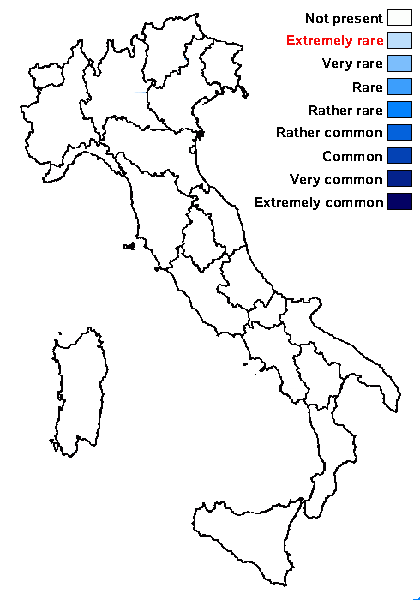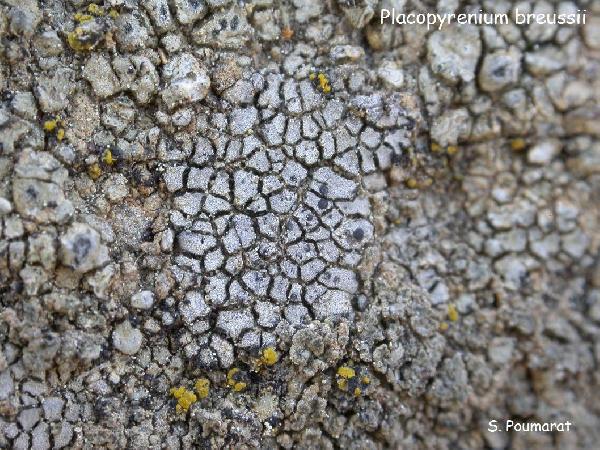Placopyrenium breussii Cl. Roux & Gueidan
Bull. Soc. linn. Provence, num. spéc. 14: 170, 2011.
Synonyms:
Distribution:
Description: Thallus crustose, episubstratic, areolate, whitish to faintly grey or grey-brown, developing on the thallis of Aspicilia calcitrapa, the areoles angular, 0.2-1 mm wide, 0.2-0.5 mm thick, whitish-pruinose, usually flat, the flanks black. Cortex paraplectenchymatous, of small, roundish-angular cells, overlain by an epinecral layer; algal layer continuous, the algal cells more or less arranged in columns; medulla white, sometimes with a dark basal layer, subparaplectenchymatous. Perithecia 0.1-0.2 mm across, fully immersed in the areoles, appearing as black dots, without involucrellum. Exciple dark in upper half, paler in lower part; hamathecium of short pseudoparaphyses, interascal filaments absent; hymenial gel hemiamyloid, I+ red (I+ blue at very low concentrations of I), K/I+ blue. Asci 8-spored, clavate, I-, fissitunicate, the wall thickened above with an indistinct ocular chamber, Verrucaria-type. Ascospores 0-1-septate, hyaline (but turning pale brown when overmature), ellipsoid, (15-)16.5-22(-27.5) x (7-)7.5-10.5(-11.5) µm, with a thin perispore, often guttulate. Pycnidia laminal, immersed, multilocular, Dermatocarpon-type, the wall colourless except around the ostiole. Conidia hyaline, short-bacilliform, 3.5-5 x 1-1.5 μm. Photobiont chlorococcoid. Spot tests: cortex and medulla K-, C-, KC-, P-, UV-. Chemistry: without lichen substances.Note: a species resembling P. formosum in the grey, areolate, non-lobate thallus, but ascospores with a thin perispore and lichenicolous on thalli of Aspicilia calcitrapa on basic to subneutral siliceous rocks in dry-warm sites; recently described from the Pyrenees and so far only known from the western Mediterranean region, with records also from the base of the Western Alps (France). To be looked for in Italy.
Growth form: Crustose
Substrata: rocks
Photobiont: green algae other than Trentepohlia
Reproductive strategy: mainly sexual
paras Aspicilia calcitrapa

Predictive model
Growth form: Crustose
Substrata: rocks
Photobiont: green algae other than Trentepohlia
Reproductive strategy: mainly sexual
paras Aspicilia calcitrapa

Predictive model


